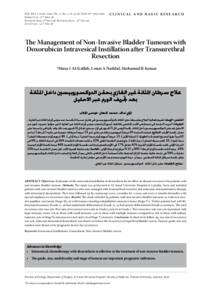Document
The Management of non-Invasive bladder tumours with doxorubicin intravesical instillation after transurethral resection.
Contributors
Naddaf, Louai A., Author
Kanan, Mohamad R., Author
Other titles
علاج سرطان المثانة غير الغازي بحقن الدوكسوروبيسين داخل المثانة بعد تجريف الورم عبر الاحليل
Publisher
College of Medicine, Sultan Qaboos University.
Gregorian
2009-04
Language
English
Subject
English abstract
Objectives: Evaluation of the intravesical instillation of doxorubicin for its effect on disease recurrence for patients with non-invasive bladder tumour. Methods: The trial was performed at Al Assad University Hospital in Lattakia, Syria and included patients with non–invasive bladder tumours who were managed with transurethral resection and induction and maintenance therapy with intravesical doxorubicin. They were followed up by cystoscopy every 3 months for 2 years and every 6 months thereafter with special emphasis on recurrence rates. Results: The trial included 85 patients with non–invasive bladder tumours: 23 with non-invasive papillary carcinoma (Stage Ta), 62 with tumour invading subepithelial connective tissue (Stage T1). Twelve patients had well differentiated tumours (Grade 1), 48 were moderately differentiated (Grade 2), 25 were poorly differentiated (Grade 3). The total recurrence rate was 23%. The rates of recurrence were 56% in Grade 3 and 0% in Grade 1. The recurrence rate was 41% in patients with large tumours versus 17% in those with small tumours; 44% in those with multiple tumours compared to 18% in those with solitary tumours; 30% of Stage Ta tumours recurred and 21% of Stage T1 tumours. Conclusion: In short term follow-up, our rate of recurrence was 23% compared to 54% in multicentre international studies without the intravesical adjuvant; thus adjuvant intravesical doxorubicin was shown to reduce the recurrence of superficial bladder cancer. Tumour grade, size and number were shown to be prognostic factors for recurrence.
Member of
Resource URL
Citation
Al-Gallab, Musa I., Naddaf, Louai A., & Kanan, Mohamad R. (2009). The Management of Non-Invasive Bladder Tumours with Doxorubicin Intravesical Instillation after Transurethral Resection. Sultan Qaboos University Medical Journal, 9 (1), 53–58.
Arabic abstract
الهدف تقير عالية العلاج بواسطة حقن المثانة بالدوكسوروبيسين في تقليل نسبة النكسة عند مرضى أورام المثانة غير الغازية . الطريقة: أجريت الدراسة في مستشفى الأسد الجامعي باللاذقية (سوريا) وشملت مرضى أورام المثانة غير الغازية الذين عولجوا بتجريف الورم عبر الاحليل ثم حقن الدوكسوروبيسين داخل المثانة. راقبنا المرضى كل 3 أشهر في أول سنتين ثم كل 6 أشهر بعد ذلك. وقد ركزنا في دراستنا على معدل نكسة الأورام النتائج شملت الدراسة 85 مريضاً لديهم ورم مثانة غير غازي. لدى 23 مريضاً سرطانة حليمية غير غازية ( المرحلة أ) و لدى 62 ورماً يغزو النسيح الضام تحت الظهارة ( المرحلة الأولى). 12 مريضاً لديهم أورام جيدة التمايز ( درجة أولى ) . 48 لديهم أورام متوسطة التمايز ( درجة ثانية ) . 25 كانت سيئة التمايز ( درجة ثالثة ) . بلغ معدل النكسة الكلي .%23. و كانت معدلات النكسة 56% في الدرجة الثالثة و %0 في الدرجة الأولى. كانت نكسة الأورام الكبيرة 41% مقابل 17% في الأورام الصغيرة و كانت نكسة الأورام المتعددة 44% بينما نكسة الأورام الوحيدة 18%. بينما كانت نكسة أورام المرحلة أ 30 و 21% من أورام المرحلة الأولى الخلاصة: بعد متابعة قصيرة الأمد. كان معدل النكسة لدينا 23 مقارنة بـ %54% في دراسة عالمية متعددة المراكز لم تعط علاجاً مساعداً داخل المثانة وبالتالي يبدو أن العلاج المساعد داخل المثانة بالدوكسوروبيسين يقلل نكسة سرطان المثانة السطحي، يبدو أن درجة الورم وحجمه وعدد الأورام هي عوامل إنذاريه للنكسة.
Category
Journal articles

